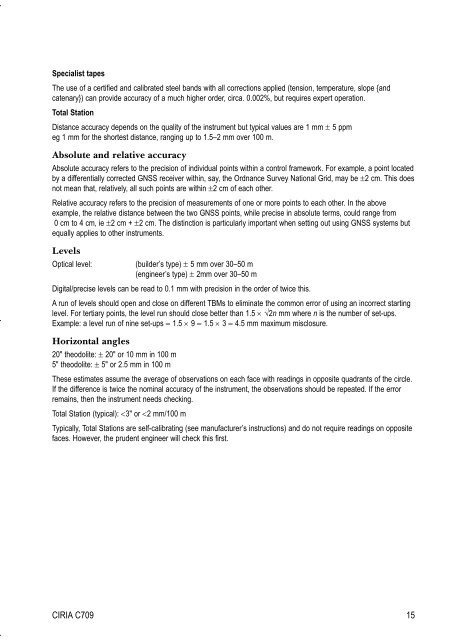Download - Engineering Surveyor
Download - Engineering Surveyor
Download - Engineering Surveyor
- No tags were found...
Create successful ePaper yourself
Turn your PDF publications into a flip-book with our unique Google optimized e-Paper software.
Specialist tapesThe use of a certified and calibrated steel bands with all corrections applied (tension, temperature, slope {andcatenary}) can provide accuracy of a much higher order, circa. 0.002%, but requires expert operation.Total StationDistance accuracy depends on the quality of the instrument but typical values are 1 mm ± 5 ppmeg 1 mm for the shortest distance, ranging up to 1.5–2 mm over 100 m.Absolute and relative accuracyAbsolute accuracy refers to the precision of individual points within a control framework. For example, a point locatedby a differentially corrected GNSS receiver within, say, the Ordnance Survey National Grid, may be ±2 cm. This doesnot mean that, relatively, all such points are within ±2 cm of each other.Relative accuracy refers to the precision of measurements of one or more points to each other. In the aboveexample, the relative distance between the two GNSS points, while precise in absolute terms, could range from0 cm to 4 cm, ie ±2 cm + ±2 cm. The distinction is particularly important when setting out using GNSS systems butequally applies to other instruments.LevelsOptical level:(builder’s type) ± 5 mm over 30–50 m(engineer’s type) ± 2mm over 30–50 mDigital/precise levels can be read to 0.1 mm with precision in the order of twice this.A run of levels should open and close on different TBMs to eliminate the common error of using an incorrect startinglevel. For tertiary points, the level run should close better than 1.5 × √2n mm where n is the number of set-ups.Example: a level run of nine set-ups = 1.5 × 9 = 1.5 × 3 = 4.5 mm maximum misclosure.Horizontal angles20" theodolite: ± 20" or 10 mm in 100 m5" theodolite: ± 5" or 2.5 mm in 100 mThese estimates assume the average of observations on each face with readings in opposite quadrants of the circle.If the difference is twice the nominal accuracy of the instrument, the observations should be repeated. If the errorremains, then the instrument needs checking.Total Station (typical):
















